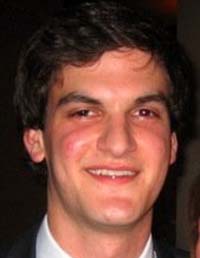Research and Hands On the Art Works for John Hawley '08
 "Learn your languages," advises Art History major John Hawley.
"You never know how important they are until you come across something
you can't read."
"Learn your languages," advises Art History major John Hawley.
"You never know how important they are until you come across something
you can't read."
It's not surprising that this is John's advice. He's held internships at museums across the country and globe, and has already worked in various areas within the field of art.
In the summer after his sophomore year, John interned at The Cloisters, a branch of the Metropolitan Museum of Art. There he mainly worked with the Education Department, giving tours to "student day-campers, particularly from Manhattan and the Bronx. I led the students around the museum's collection, focusing on certain objects which gave them a better sense of what life was like in the Middle Ages."
While studying art history, history, and Dutch abroad last academic year at the University College London, John also worked for Simon C. Dickinson, Agents and Dealers in Fine Art. "The best part of working with a dealer is the very hands-on approach to art objects. On a daily basis, I was hanging, framing, and researching works by Titian, Da Vinci, Monet, and Picasso." Working for or as a dealer might even be a career consideration, as "I really enjoyed working with the dealer in London - it combined research and close contact with the works themselves."
In his home city of Los Angeles, John has worked at both the Los Angeles County Museum of Art (LACMA) and the J. Paul Getty Museum at the Getty Center.
At LACMA he researched three works by Rembrandt, "basically combing through all the scholarship on Rembrandt for the past thirty years" to see if the pictures were mentioned. The Getty had a different problem: "The museum won't purchase art unless the provenance goes back to 1930. Unfortunately, we could only get the provenance back to 1933. Given that the object is considered a piece of decorative art, any mention of it in a dealer's inventory would have been quite generic and provided little assistance in showing that it referenced our object as opposed to a similar one."
And what about his experience here at William and Mary? "An overall positive," he says. "What Williamsburg lacks, the College makes up for." Part of the positive for John is the College's faculty. "I love the faculty, although sometimes I think they sometimes get tired of dealing with me. I'm always asking for recommendations."
Now in his senior year, John is pursuing an Honors thesis, on Thomas de Keyser's 1627 portrait of Constantijn Huygens, which began to take shape with his research as a Monroe Scholar. For his Monroe project, John explored Contanijn Huygens, a seventeenth-century Dutch poet and art collector. For the Honors project, John narrowed his focus to a 1627 Thomas De Keyser portrait of Contanijn Huygens. When Huygens commissioned the portrait, he expected Keyser to incorporate elements making ties to The Hague, his personal life, and contemporaneous culture.
Huygens's use of the portrait reflects a wide array of personal endeavors, including roles as disparate as statesman, husband, and father. Also, his early portrait commissions are intended to tie him directly to the court at The Hague, as in the 1627 portrait by Thomas de Keyser. Lastly, there is a direct association between literature and the painted image, for on numerous occasions Huygens writes poems on his portraits.
To fully understand Huygens and why he commissioned the work and "what he's trying to convey about Dutch culture," John is translating Huygens' own poetry and looking at contemporaneous literary influence. "Much of what I'm interested in is the relationship between image and text in Dutch culture. Far too often, scholars have promoted the Dutch as a purely visual people and failed to recognize the interplay between text and image."
John was accepted to graduate programs at the University of Virginia, where he received full funding through its Jefferson fellowships, but has decided to attend the Institute of Fine Art at New York University on a Javits Fellowship. "NYU is a great opportunity given its close ties to New York's major museums, dealers, and auction houses as well as the ability for me to work with my advisor Mariet Westermann on an upcoming publication on Rembrandt and his circle."















